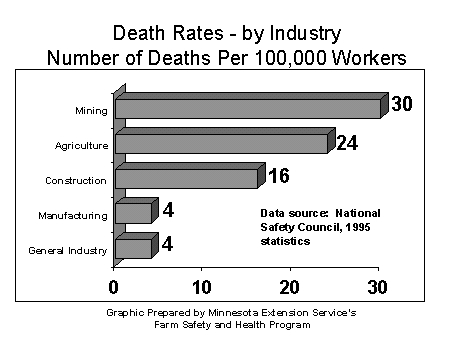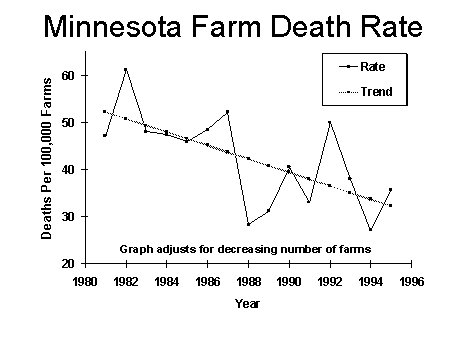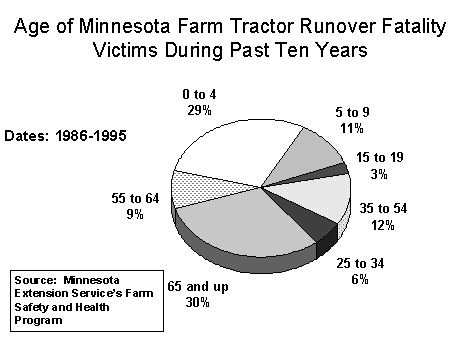There's good news and bad on the farm safety front. First the good--statistics show that agriculture is no longer the nation's most hazardous industry. From 1985 to 1994, fatality rate estimates published by the National Safety Council ranked agriculture as the nation's most hazardous industry. For nearly ten years, the rate of work-related death in agricultural occupations including farming, ranching, and commercial fishing surpassed other dangerous industries such as mining and construction. But, the Safety Council's 1996 figures show that agriculture dropped to second place, with a death rate less than half of what it was ten years ago.
The National Safety Council's statistics show agriculture with a work-related death rate of 24 per 100,000 workers, behind mining's 30 per 100,000 and 16 per 100,000 in construction. The figure shown below illustrates the death rates for various industries. The agricultural rate translates into a total of 800 workers killed per year and an estimated 140,000 disabling injuries.

Minnesota has also done well in the prevention of deadly farming-related injuries. Figures from the University of Minnesota's Extension Service show the state experienced a 10-year high number of fatalities of 47 in 1986. That number had dropped to 24 in 1994, but was back up to 31 in 1995.

Efforts to improve safety on farms appear to be working over the long haul, says John Shutske, U of M extension farm safety and health specialist. "Progress has come about as new technologies and improved designs have made machinery safer," notes Shutske. "Educational efforts by extension educators, teachers, health professionals, agricultural supply businesses, and rural community leaders have heightened awareness tremendously."
The bad news is hidden in these figures. "We're still seeing far too many deaths from tractor runovers and rollovers," says Shutske. "Also, the National Safety Council's statistics do not include children below the age of 14 even though a considerable proportion of deaths in farm workplaces involve children below this age."
During the past ten years in Minnesota, 35 people have been run over and killed by tractors or by implements such as wagons, mowers, or tillage equipment. The vast majority of these runovers were young kids. However, a fairly large number of people over age 65 get run over by equipment.

The problem with children riding on and falling off of farm machinery is not new. "We've spent decades trying to convince parents and grandparents about the hazards of 'extra riders,' yet we still see this behavior happening," says Shutske. "People think, 'That will never happen to my kid.' If parents could only be with me when I visit farm families and speak to the parents of young children who were run over and killed or seriously injured while they were driving the tractor, they might think twice about allowing kids to ride. It's a situation that can rip families apart."
By following the simple rule of NO EXTRA RIDERS, we could dramatically reduce the number of these needless deaths, says Shutske. This includes extra riders on the farm, in non-farm workplaces, county fairs, and farm shows. "Even tractors with cabs are not totally safe," Shutske points out. "We've had incidents where young children have fallen out the door of the tractor cab only to be run over by the crushing weight of the tractor and a trailing implement."
Here's a second problem area: tractor rollovers. A modern tractor usually weighs more than 10 tons. When it rolls over onto a person the result is usually a death. Even an older model tractor weighs several thousand pounds, more than enough weight to cause massive internal damage to a person's body. These same older model tractors are also the ones most likely to have a higher center of gravity, a narrow tricycle style front-end, and most dangerously, no rollover protective structure (ROPS). "Since our average tractor in Minnesota is over 25 years old, it is important that we take this issue seriously," says Shutske.
The best way to prevent tractor rollovers is to avoid operating older model, high risk tractors. "If you have a different machine that is equipped with rollover protection, it's a much wiser choice," Shutske points out. "If you have an older tractor with no ROPS, another option is to purchase an add-on ROPS from your machinery dealer."
For more facts about preventing tractor runover and rollover deaths including information about the availability of ROPS for your older tractor, contact the Minnesota Extension Service Farm Safety and Health Program at (612) 624-7444.
Web,DTN,V4MN,V5MN,A4,E4
NAGR5333 Source:
John Shutske, (612) 626-1250
Editor: Joseph Kurtz, EDS, (612) 625-3168
Disclaimer and Reproduction Information: Information in NASD does not represent NIOSH policy. Information included in NASD appears by permission of the author and/or copyright holder. More